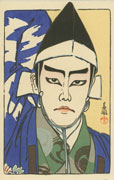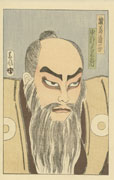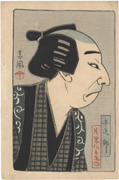Prints in Collection
Yaozō
in the role of Kiyomasa, 1915
IHL Cat. #231Nizaemon
in the role of Hachirōbei, 1915
(attributed to Seifū)
IHL Cat. #347Kōshirō
in the role of Chōbei, 1915
IHL Cat. #233
Tosshi
in the role of Araki Mataemon, 1915
IHL Cat. #232Sadanji
in the role of Togashi, 1915
IHL Cat. #279Nakamura Kichiemon
in the role of Katō Kiyomasa, 1915
IHL Cat. #278
Sawamura Gennosuke (IV)
in the role of Otomi, 1915
IHL Cat. #1319
Kataoka Nizaemon in the role of Yōjirō, 1915
IHL Cat. #2178
-intentionally left blank-
Biographical Data
Biography
Matsuda Seifū 松田青風 (1892-1941) Artist's name (right to left) 松田青風 followed by the character 畫 (picture) as printed on a print presentation sheet in the magazine Shin Nigao |
There is little information available in English about the Japanese artist Matsuda Seifū. Kendall Brown in Shin-Hanga: New Prints in Modern Japan gives Matsuda's dates of existence as 1880-19781, but the National Library of Australia provides the dates 1896/7-1943 ,as well as 1892-1941,2 and I have seen 1892-1941 given by several Japanese web sites, including The Tsubouchi Memorial Theatre Museum as well as by the Library of Congress3. We do know that an artist with the name Matsuda Seifū created a number of small prints of kabuki actors (nigao-e) for the 1915 art magazine, Shin Nigao and is also credited with the design of a series of actor prints in chuban format (about 7 1/2" x 10") around the same time.
It is likely that the author and illustrator Matsuda Seifū, who illustrated and wrote several books on the wigs (katsura) used in kabuki4, is one and the same as the artist who designed the Kabuki actor prints that appeared in Shin Nigao.
It is also possible, if one accepts the birth and death dates of 1880 and 1978 for the Matsuda Seifū who created actor prints, that he is one in the same with the artist Tsuda Seifū 津田青楓 (1880-1978), the Kyoto-born painter who also designed woodblock prints.
Tsuda Seifū was a contemporary of Ishii Hakutei's (1882-1958) whose sojourn in Paris from 1907-1911 overlapped with Ishii's. Tsuda, along with Ishii and the novelist and painter Arishima Kiuma, founded the Nikakai (Second Division Society) Exhibition in 1914 or 1915 as a rival to the official government exhibition. Tsuda's most famous work is, perhaps, The Victim, a 1933 oil painting, which shows the death of proletarian novelist Kobayashi Takiji who had been tortured by the military police.5 Merritt notes that "at some point, probably while working in Kyoto before the Russo-Japanese War, at the suggestion of Asai Chū (1856-1907), he designed and probably self-carved a number of blocks, which Yamada Naozo of Unsōdō (Unsōdō Publishing) published under the title Small Art (Ko bijutsu). [He] also made many moku-hanga for book illustrations in the years immediately following his return from France."6
However, I can find no reference in the literature mentioning Tsuda Seifū that suggests he had specific interest in kabuki, leaving it all a bit of a mystery.
1 Shin-Hanga: New Prints in Modern Japan, Kendall Brown, Hollis Goodall-Cristante, Los Angeles County Museum of Art, 1996, p. 87.
2 website of the National Library of Australia http://catalogue.nla.gov.au/Search/Home?lookfor=author:%22Matsuda%2C%20Seifu%22&iknowwhatimean=1
3 Library of Congress website http://id.loc.gov/authorities/names/no2010085156
4 e.g. Kabuki no katsura which contains 670 drawings representing 400 types of wigs, published in 1959 by Engeki Shuppansha
5 The Dark Years: 1931-1945, David Elliott, English translation of text appearing in the catalog for the 2006 exhibition "Tokyo-Berlin / Berlin-Tokyo" held at the Mori Art Museum, Tokyo. Online at http://www.mori.art.museum/english/contents/tokyo-berlin/about/img/The_Dark_Years.pdf
6 Guide to Modern Japanese Woodblock Prints: 1900-1975, Helen Merritt, University of Hawaii Press, 1992, p. 157.






